Enhancing Acoustic Emission Characteristics in Pipe-Like Structures with Gradient-Index Phononic Crystal Lens
Abstract
:1. Introduction
2. Materials and Methods
2.1. GRIN Lens Design
2.1.1. Specifications
2.1.2. Numerical Verification
2.2. Experimental Design
3. Results and Discussion
3.1. Simulations Using Pencil Lead Break
3.2. Attenuation Curves at the Focal Line
3.3. Detecting Leak Using GRIN-AE
4. Conclusions
Author Contributions
Funding
Data Availability Statement
Conflicts of Interest
Abbreviations
| AE | Acoustic Emission |
| GRIN | Gradient-Index |
| HS | Hyperbolic Secant |
| PLB | Pencil Lead Break |
| CWT | Continuous Wavelet Transform |
References
- US DOT Pipeline and Hazardous Materials Safety Administration (PHMSA). All Reported Incidents Summary Statistics: 2000–2020; PHMSA: Washington, DC, USA, 2020. [Google Scholar]
- European Gas Pipeline Incident Data Group (EGIG). In Proceedings of the 10th EGIG-Report 1970–2016 Gas Pipeline Incidents, Groningen, The Netherlands, 2018; Available online: https://www.egig.eu/reports/$97/$157 (accessed on 22 March 2021).
- Quiroga, J.L.; Quiroga, J.E.; Diaz, P.P. Comparative Study of Three Non-Destructive Techniques for Metal Loss Inspection in Pipe Walls. IOP Conf. Ser. Mater. Sci. Eng. 2019, 578. [Google Scholar] [CrossRef] [Green Version]
- Murvay, P.S.; Silea, I. A Survey on Gas Leak Detection and Localization Techniques. J. Loss Prev. Process Ind. 2012, 25, 966–973. [Google Scholar] [CrossRef]
- Miller, R.K.; Pollock, A.A.; Watts, D.J.; Carlyle, J.M.; Tafuri, A.N.; Yezzi, J.J. A Reference Standard for the Development of Acoustic Emission Pipeline Leak Detection Techniques. NDT E Int. 1999, 32, 1–8. [Google Scholar] [CrossRef]
- Zaman, D.; Tiwari, M.K.; Gupta, A.K.; Sen, D. A Review of Leakage Detection Strategies for Pressurised Pipeline in Steady-State. Eng. Fail. Anal. 2020, 109, 104264. [Google Scholar] [CrossRef]
- Rizzo, P. Water and Wastewater Pipe Nondestructive Evaluation and Health Monitoring: A Review. Adv. Civ. Eng. 2010, 2010. [Google Scholar] [CrossRef] [Green Version]
- Šofer, M.; Cienciala, J.; Fusek, M.; Pavlíček, P.; Moravec, R. Damage Analysis of Composite CFRP Tubes Using Acoustic Emission Monitoring and Pattern Recognition Approach. Materials 2021, 14, 786. [Google Scholar] [CrossRef]
- Grosse, C.U.; Ohtsu, M. Acoustic Emission Testing; Springer: Berlin/Heidelberg, Germany, 2008. [Google Scholar] [CrossRef]
- Juliano, T.M.; Meegoda, J.N.; Watts, D.J. Acoustic Emission Leak Detection on a Metal Pipeline Buried in Sandy Soil. J. Pipeline Syst. Eng. Pract. 2013, 4, 149–155. [Google Scholar] [CrossRef]
- Ozevin, D.; Harding, J. Novel Leak Localization in Pressurized Pipeline Networks Using Acoustic Emission and Geometric Connectivity. Int. J. Press. Vessel. Pip. 2012, 92, 63–69. [Google Scholar] [CrossRef]
- Ozevin, D.; Yalcinkaya, H. New Leak Localization Approach in Pipelines Using Single-Point Measurement. J. Pipeline Syst. Eng. Pract. 2014, 5, 04013020. [Google Scholar] [CrossRef]
- Mostafapour, A.; Davoudi, S. Analysis of Leakage in High Pressure Pipe Using Acoustic Emission Method. Appl. Acoust. 2013, 74, 335–342. [Google Scholar] [CrossRef]
- Lu, H.; Iseley, T.; Behbahani, S.; Fu, L. Leakage Detection Techniques for Oil and Gas Pipelines: State-of-the-Art. Tunn. Undergr. Sp. Technol. 2020, 98. [Google Scholar] [CrossRef]
- Lumb, R.F. Inspection of Pipelines Using Nondestructive Techniques. Phys. Technol. 1977, 8, 249–256. [Google Scholar] [CrossRef]
- Mitra, M.; Gopalakrishnan, S. Guided Wave Based Structural Health Monitoring: A Review. Smart Mater. Struct. 2016, 25. [Google Scholar] [CrossRef]
- Ghavamian, A.; Mustapha, F.; Baharudin, B.T.H.T.; Yidris, N. Detection, Localisation and Assessment of Defects in Pipes Using Guided Wave Techniques: A Review. Sensors 2018, 18, 4470. [Google Scholar] [CrossRef] [PubMed] [Green Version]
- Kannan, E.; Maxfield, B.W.; Balasubramaniam, K. SHM of Pipes Using Torsional Waves Generated by in Situ Magnetostrictive Tapes. Smart Mater. Struct. 2007, 16, 2505–2515. [Google Scholar] [CrossRef]
- Muggleton, J.M.; Rustighi, E.; Gao, Y. Remote Pipeline Assessment and Condition Monitoring Using Low-Frequency Axisymmetric Waves: A Theoretical Study of Torsional Wave Motion. J. Phys. Conf. Ser. 2016. [Google Scholar] [CrossRef] [Green Version]
- Lowe, P.S.; Serson, R.; Pedram, S.K.; Boulgouris, N.V.; Mudge, P. Inspection of Pipelines Using the First Longitudinal Guided Wave Mode. Phys. Procedia 2015, 70, 338–342. [Google Scholar] [CrossRef] [Green Version]
- Ovchinnikov, A.L.; Lapshin, B.M. Low-Frequency Acoustic Signals Propagation in Buried Pipelines. J. Phys. Conf. Ser. 2016, 671. [Google Scholar] [CrossRef] [Green Version]
- Feng, Q.; Kong, Q.; Huo, L.; Song, G. Crack Detection and Leakage Monitoring on Reinforced Concrete Pipe. Smart Mater. Struct. 2015, 24. [Google Scholar] [CrossRef]
- Egerton, J.S. Ultrasonic Inspection of Highly Attenuating Media. Ph.D. Thesis, Imperial College London, London, UK, 2018. [Google Scholar]
- Ono, K. A Comprehensive Report on Ultrasonic Attenuation of Engineering Materials, Including Metals, Ceramics, Polymers, Fiber-Reinforced Composites, Wood, and Rocks. Appl. Sci. 2020, 10, 2230. [Google Scholar] [CrossRef] [Green Version]
- Jin, Y.; Djafari-Rouhani, B.; Torrent, D. Gradient Index Phononic Crystals and Metamaterials. Nanophotonics 2018, 8, 685–701. [Google Scholar] [CrossRef]
- Lin, S.-C.S.; Huang, T.J.; Sun, J.-H.; Wu, T.-T. Gradient-index phononic crystals. Phys. Rev. B 2018, 79, 094302. [Google Scholar] [CrossRef] [Green Version]
- Climente, A.; Torrent, D.; Sánchez-Dehesa, J. Omnidirectional broadband acoustic absorber based on metamaterials. Appl. Phys. Lett. 2012, 100, 144103. [Google Scholar] [CrossRef]
- Tol, S.; Degertekin, F.L.; Erturk, A. Gradient-Index Phononic Crystal Lens-Based Enhancement of Elastic Wave Energy Harvesting. Appl. Phys. Lett. 2016, 109. [Google Scholar] [CrossRef]
- Tol, S.; Degertekin, F.L.; Erturk, A. 3D-Printed Phononic Crystal Lens for Elastic Wave Focusing and Energy Harvesting. Addit. Manuf. 2019, 29, 100780. [Google Scholar] [CrossRef]
- Hyun, J.; Choi, W.; Kim, M. Gradient-index phononic crystals for highly dense flexural energy harvesting. Appl. Phys. Lett. 2019, 115, 173901. [Google Scholar] [CrossRef]
- Wu, T.-T.; Chen, Y.-T.; Sun, J.-H.; Lin, S.-C.; Huang, T. Focusing of the lowest antisymmetric lamb wave in a gradient-index phononic crystal plate. Appl. Phys. Lett. 2011, 98. [Google Scholar] [CrossRef]
- Zhao, J.; Marchal, R.; Bonello, B.; Boyko, O. Efficient focalization of antisymmetric lamb waves in gradient-index phononic crystal plates. Appl. Phys. Lett. 2012, 101, 261905. [Google Scholar] [CrossRef]
- Danawe, H.; Okudan, G.; Ozevin, D.; Tol, S. Conformal gradient-index metamaterial lens for wave focusing in pipe-like structures. Appl. Phys. Lett. 2020, 117. [Google Scholar] [CrossRef]
- Wu, X.; Sun, L.; Zuo, S.; Liu, P.; Huang, H. Vibration reduction of car body based on 2D dual-base locally resonant phononic crystal. Appl. Acoust. 2019, 151, 1–9. [Google Scholar] [CrossRef]
- Zhu, X.; Zhong, S.; Zhao, H. Band gap structures for viscoelastic phononic crystals based on numerical and experimental investigation. Appl. Acoust. 2016, 106, 93–104. [Google Scholar] [CrossRef]
- Tol, S.; Okudan, G.; Ozevin, D. Wave focusing in pipe-like structures via gradient-index metamaterial lens toward damage detection and localization. Proc. SPIE 2019, 10970, 109700D. [Google Scholar] [CrossRef]
- Gómez-Reino, C.; Perez, M.V.; Bao, C. Gradient-Index Optics: Fundamentals and Applications; Springer: Berlin/Heidelberg, Germany, 2002. [Google Scholar] [CrossRef]
- Okudan, G.; Danawe, H.; Zhang, L.; Tol, S.; Ozevin, D. Reciprocal amplification of wave front for planar or point sources using a metamaterial lens to increase the inspection distance of pipelines. Proc. SPIE 2020, 11380, 113800V. [Google Scholar] [CrossRef]
- ASTM 2015 Standard Guide for Determining the Reproducibility of Acoustic Emission Sensor Response E976-15; American Society for Testing and Materials: West Conshohocken, PA, USA, 2015. [CrossRef]
- Bentley, P.M.; McDonnell, J.T.E. Wavelet transforms: An introduction. IEEE Electron. Commun. Eng. J. 1994, 6, 175–186. [Google Scholar] [CrossRef]
- Danawe, H.; Okudan, G.; Ozevin, D.; Tol, S. Metamaterial-based amplification of multi-mode ultrasonic guided waves toward improved damage detection in pipelines. Proc. SPIE 2020, 11376, 113761N. [Google Scholar] [CrossRef]

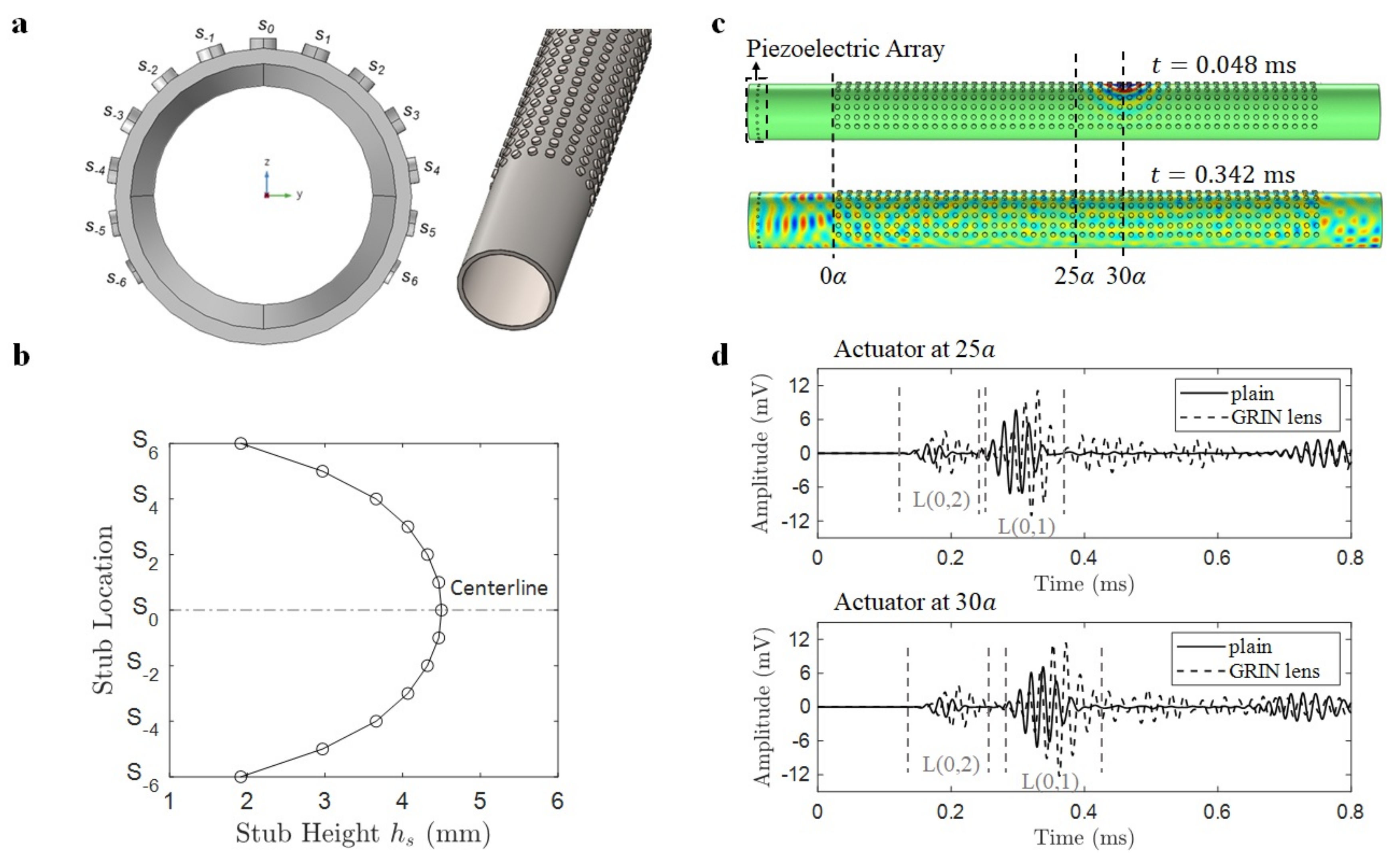
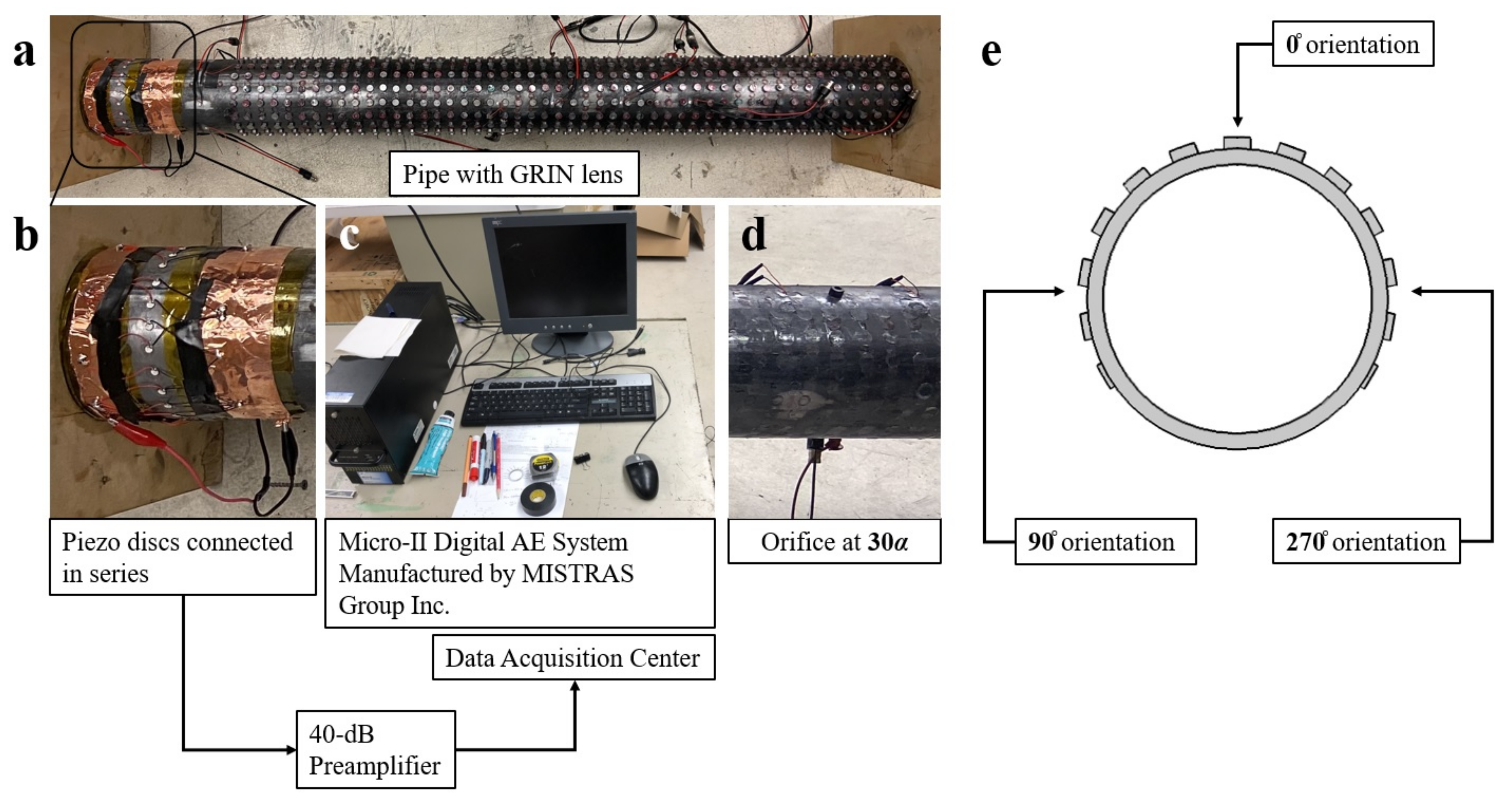
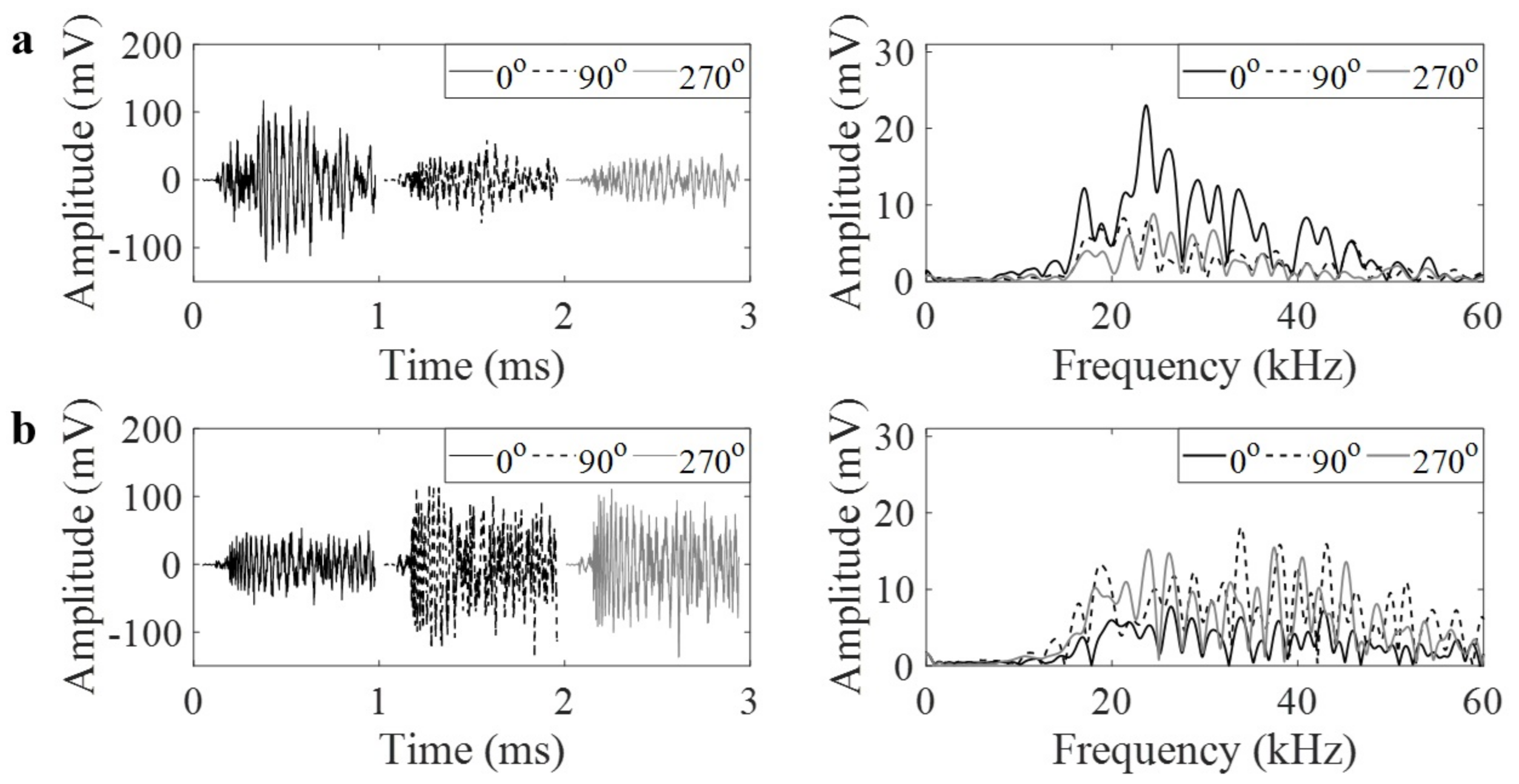

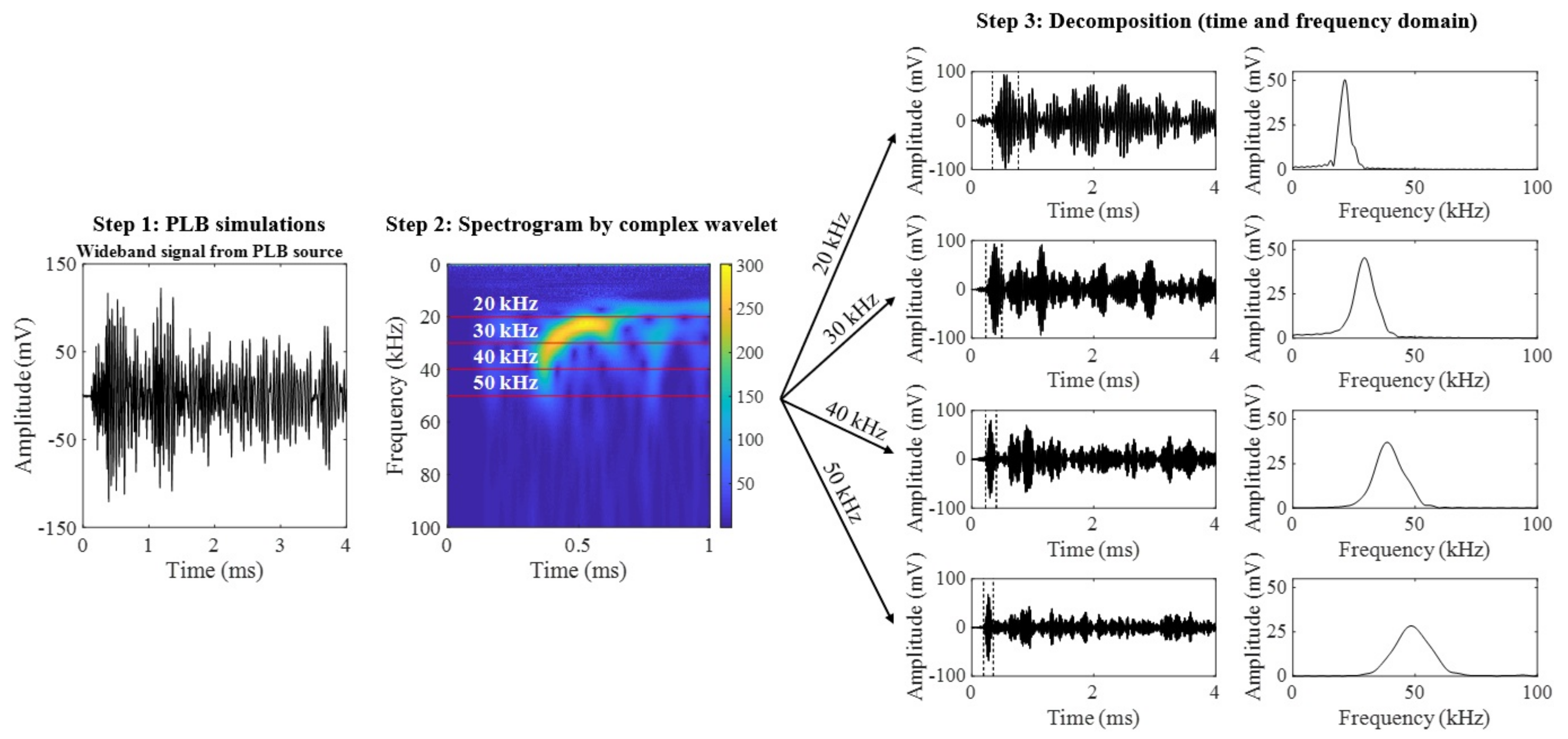
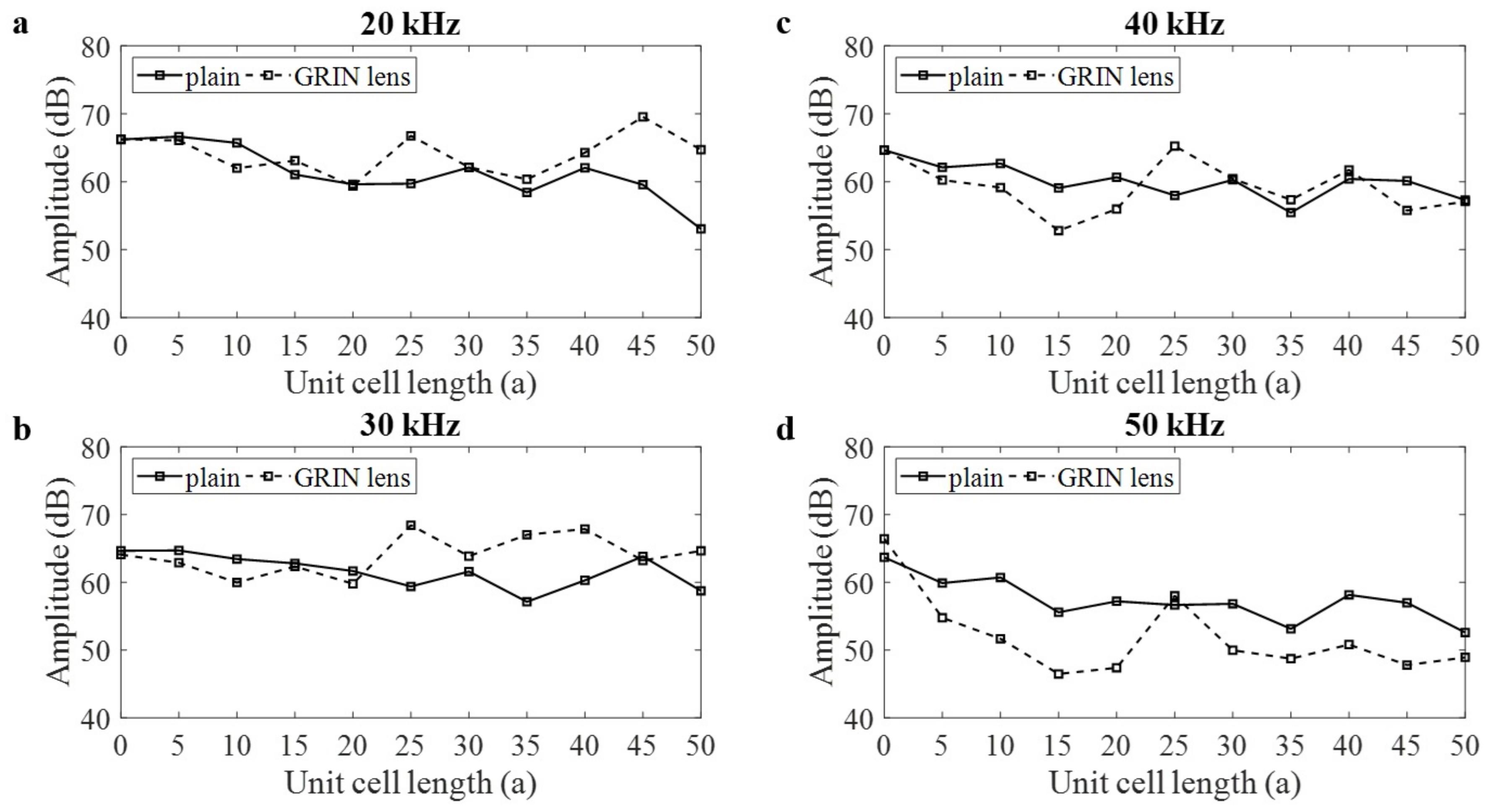
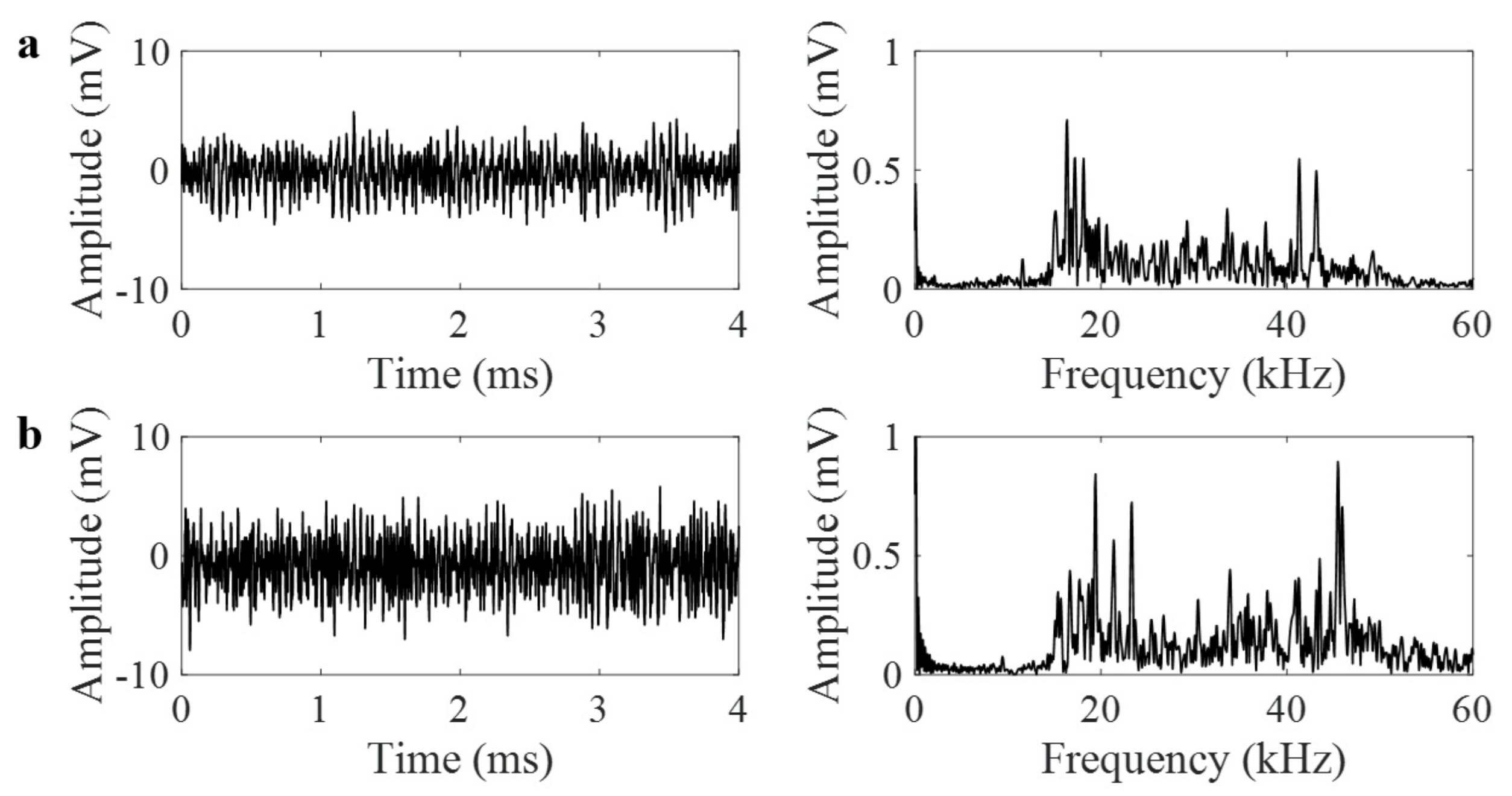
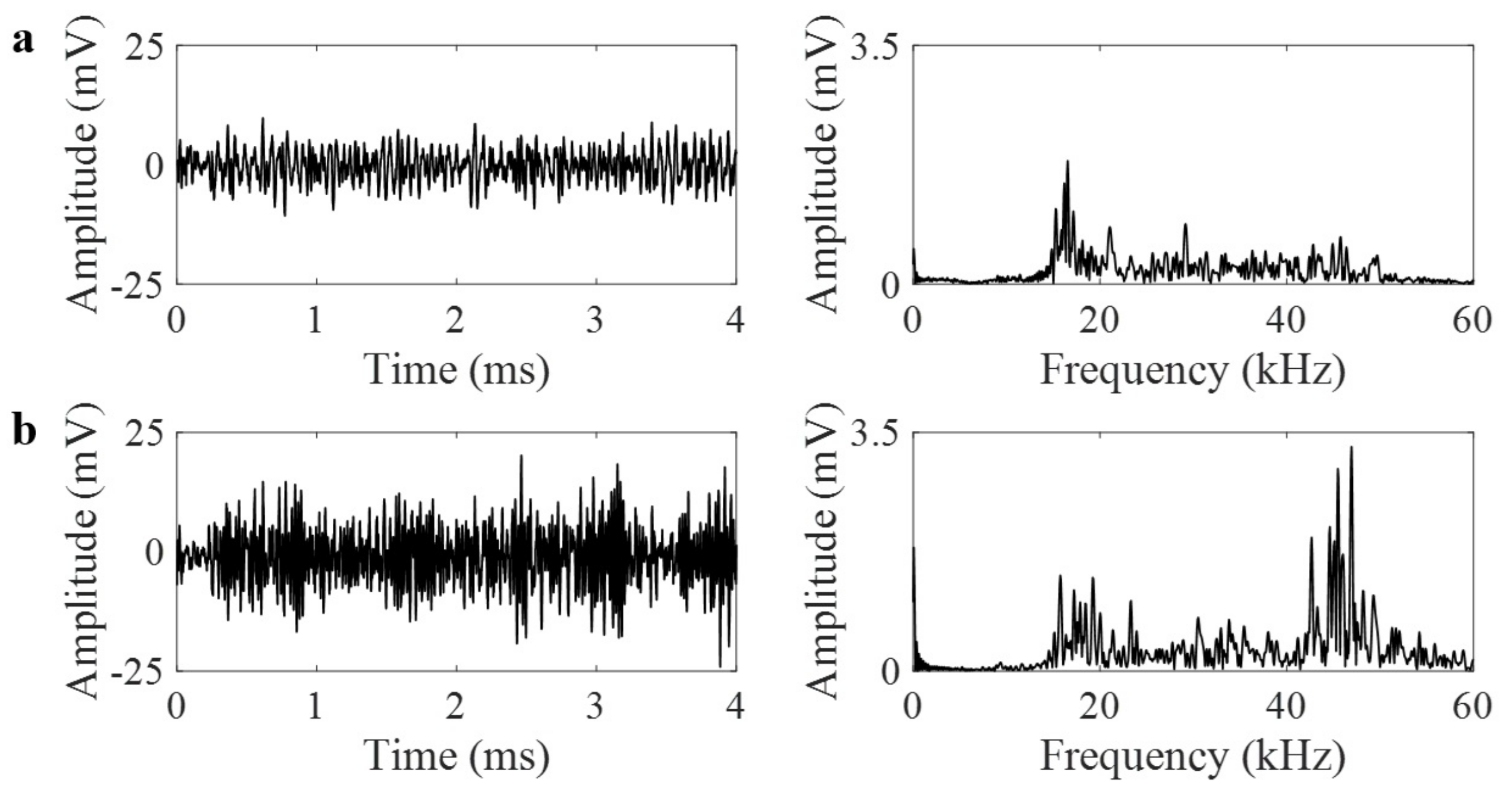
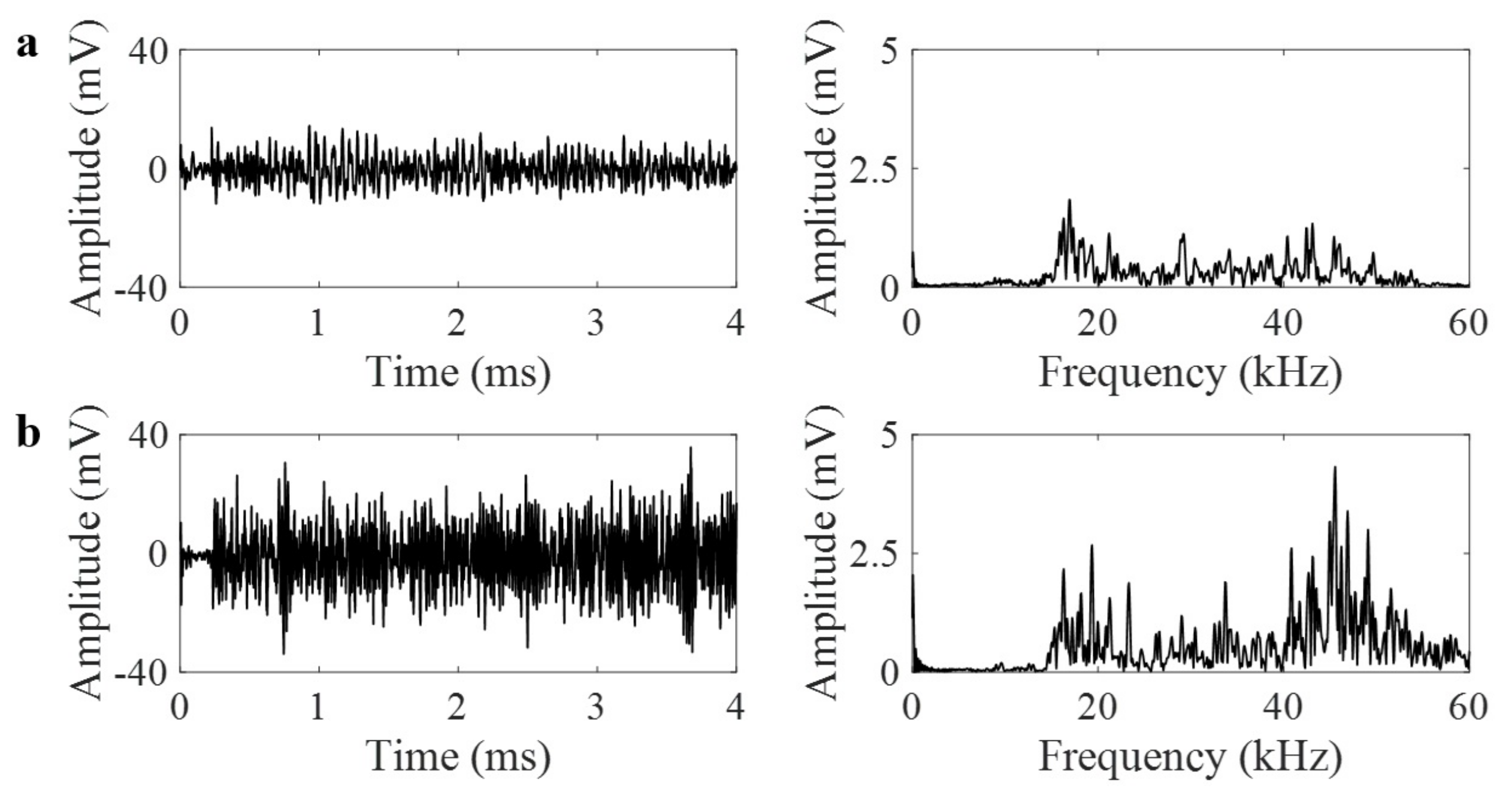

Publisher’s Note: MDPI stays neutral with regard to jurisdictional claims in published maps and institutional affiliations. |
© 2021 by the authors. Licensee MDPI, Basel, Switzerland. This article is an open access article distributed under the terms and conditions of the Creative Commons Attribution (CC BY) license (http://creativecommons.org/licenses/by/4.0/).
Share and Cite
Okudan, G.; Danawe, H.; Zhang, L.; Ozevin, D.; Tol, S. Enhancing Acoustic Emission Characteristics in Pipe-Like Structures with Gradient-Index Phononic Crystal Lens. Materials 2021, 14, 1552. https://doi.org/10.3390/ma14061552
Okudan G, Danawe H, Zhang L, Ozevin D, Tol S. Enhancing Acoustic Emission Characteristics in Pipe-Like Structures with Gradient-Index Phononic Crystal Lens. Materials. 2021; 14(6):1552. https://doi.org/10.3390/ma14061552
Chicago/Turabian StyleOkudan, Gorkem, Hrishikesh Danawe, Lu Zhang, Didem Ozevin, and Serife Tol. 2021. "Enhancing Acoustic Emission Characteristics in Pipe-Like Structures with Gradient-Index Phononic Crystal Lens" Materials 14, no. 6: 1552. https://doi.org/10.3390/ma14061552






